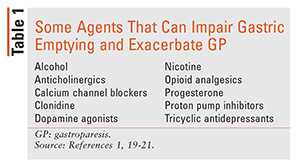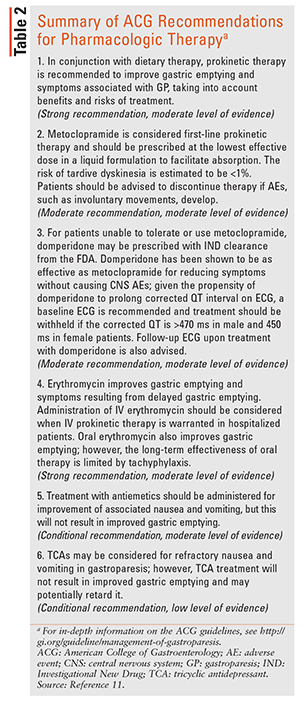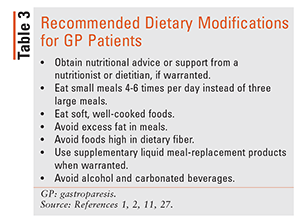US Pharm. 2018;43(12):26-34.
ABSTRACT: Gastroparesis (GP) is a chronic neuromuscular disorder of the upper gastrointestinal tract that is characterized by a delay in gastric emptying that lessens the ability of the stomach to empty in the absence of an obstruction. GP can significantly impact a patient’s quality of life. Although the exact cause of GP is unknown, the three primary classifications are diabetic, postsurgical, and idiopathic. GP may be exacerbated by the use of certain pharmacologic agents, such as opioids. Pharmacists are in a pivotal position to identify agents that may delay gastric emptying in this patient population. To date, treatment options are limited but may include dietary modification, medications to accelerate gastric emptying, antiemetic agents, gastric electrical stimulation, and surgery.
According to the American College of Gastroenterology (ACG), the literal translation of gastroparesis (GP) is “stomach paralysis.”1 GP, a chronic neuromuscular disorder of the upper gastrointestinal (GI) tract, is characterized by a delay in gastric emptying that diminishes the stomach’s ability to empty in the absence of an obstruction.2 The etiology of GP is diverse, but there are three main classifications: idiopathic, diabetic, and postsurgical.2,3 Although the incidence of GP is not well documented, it is estimated that 4 million to 5 million people in the United States are affected by GP, to varying degrees.2,3 Hospitalizations with GP as the primary diagnosis have increased in the past 20 years, including a dramatic upsurge after 2000, possibly because of multifactorial causes.4,5 The increasing prevalence of diabetes; changes in GP diagnostic criteria, severity, and treatment; or better recognition and diagnosis of this disorder may contribute to the increase in GP hospitalizations.4,5 In addition, some case series report an association between GP and increased rates of morbidity and mortality.4,6
GP presents various challenges for affected patients, and these challenges can negatively impact overall quality of life (QoL).7 GP has also been associated with anxiety and depression.7 A 2018 survey concluded that GP reduces patient QoL and places a substantial financial burden on the patient and the healthcare system.7 In this survey, 67.5% of patients reported that GP symptoms impaired their ability to perform daily activities, 28% stated that the condition lowered their annual income owing to lost productivity, and 11% were disabled because of GP-related symptoms.7
Pathophysiology and Risk Factors
Studies have demonstrated that GP does not develop from a single pathophysiological process; rather, GP symptoms are caused by a variety of physiological abnormalities that differ from patient to patient.8 The pathophysiology of GP is often multifactorial and may include abnormalities in fundic tone, antroduodenal dyscoordination, a weak antral pump, gastric dysrhythmias, and abnormal duodenal feedback, all of which contribute to delays in gastric emptying and symptom expression.8 Although the exact cause of GP is unknown, the three primary types are diabetic, postsurgical, and idiopathic.8-10 Approximately 25% of GP cases are associated with diabetes, whereas nearly 50% are classified as idiopathic; many idiopathic cases likely represent a postinfectious process.8 Connective-tissue disorders, autoimmune disorders, neurologic disorders, prior gastric surgery, ischemia, and use of certain pharmacologic agents account for the vast majority of the remaining GP cases.8-10 Postsurgical GP is often the result of injury to the vagus nerve, which is responsible for controlling the movement of food through the digestive tract.10,11 Persons with eating disorders (i.e., anorexia nervosa or bulimia) may also be at greater risk for developing delayed gastric emptying.12 With regard to eating disorders, normal gastric emptying may resume and symptoms may improve when intake of food and calories is sufficient.12
Diabetes is the most commonly recognized medical condition associated with GP.11 According to the American Diabetes Association (ADA), GP can exacerbate diabetes, making it more difficult to control blood glucose levels.11,13 The ADA indicates that one of the most important goals for managing diabetes-related GP is to maintain tight glycemic control.11,13 Pharmacologic management of diabetes may also affect gastric motility. Endogenous glucagon-like peptide-1 (GLP-1) slows gastric emptying; therefore, exogenous GLP-1 analogues and dipeptidyl peptidase 4 inhibitors could theoretically delay gastric emptying.14-18 However, clinical studies have not found that these therapies have any effect on gastric emptying.14-18
In addition, several pharmacologic agents have the potential to cause delays in gastric emptying, which may exacerbate GP.1,19-21 The pharmacologic agents most commonly associated with delayed stomach emptying are narcotic opiate analgesics and certain antidepressants.1,19-21 Other agents that may delay gastric emptying are listed in TABLE 1.1,19-21 Typically, patients experiencing drug-related delayed gastric emptying (sometimes referred to as pseudogastroparesis) show signs of improvement when the agents are discontinued.1

Symptoms of GP
Cardinal symptoms of GP include nausea (occurring in an estimated 90% of patients), vomiting (84% of patients), and early satiety (60% of patients).9,11,18 Other symptoms include postprandial fullness and upper abdominal pain, with an estimated 90% of GP patients reporting epigastric pain.9,18,22 Patients with GP may present with variations in symptoms depending on the etiology. For example, abdominal pain occurs more often in idiopathic GP than in diabetic GP, whereas nausea and vomiting are more severe in diabetic than in idiopathic GP.18,22 Weight loss, malnutrition, and dehydration may be prominent in those with severe GP.18,22 The ACG’s clinical guidelines recommend that patients with GP be screened for diabetes, thyroid dysfunction, neurologic disease, history of bariatric surgery, and autoimmune disorders as possible underlying causes of GP.2,11
Treatment of GP
Regardless of etiology, limited medication options are available for patients with GP.4 Once the diagnosis is confirmed, options may include one or more of the following therapies: dietary modification, medications to accelerate gastric emptying, antiemetics, gastric electrical stimulation, and surgery.2,8,11 The objectives of treatment are to correct nutritional deficiencies, decrease symptoms, and pursue the etiology in the hope of correcting the underlying cause of GP.2 Combination strategies that focus on these three objectives are the key to management.2
In 2013, the ACG released its updated recommendations for the evaluation and management of patients with GP. According to the ACG, management should include assessment and modification of diet, symptom relief, enhanced gastric emptying, and maintenance of tight glycemic control in diabetic patients.2,11 Dietary modification is considered first-line therapy in patients with mild GP.8 Meals should be small, frequent, and limited in fat and fiber, which tend to delay emptying; the goal should be at least four to six small meals daily, and supplementation with high-calorie liquids can help nutritionally without causing symptoms in mild GP.2,11
Currently approved treatments include metoclopramide and gastric electrical stimulation, and medical therapy typically involves the use of prokinetics and antiemetics.2,8,11 Dopamine receptor antagonists inhibit the effects of dopamine on GP and also act as a serotonin antagonist to address nausea.2,8,11 The use of prokinetics has long been a standard treatment for GP.2,8 To date, metoclopramide is the only agent FDA-approved specifically for the treatment of GP for no longer than a 12-week duration, except in patients in whom there is a therapeutic benefit that outweighs the potential for adverse effects.2,8,11
Metoclopramide is a potent dopamine D2 receptor antagonist and serotonin receptor agonist that acts on the brainstem and peripheral nerves.18 It exerts its pharmacologic effect by stimulating stomach-muscle contractions to aid in gastric emptying.2,11 In the GI tract, it increases contractions of the gastric antrum by releasing acetylcholine from enteric neurons.18,23 The central effects may account, in some part, for the reduction of nausea.18
An early double-blind, placebo-controlled trial of 40 patients with diabetic GP discovered that metoclopramide 10 mg four times daily by mouth produced noteworthy improvements in meal tolerance, symptoms of GP, and gastric emptying during 3 weeks of administration.24 Metoclopramide should be prescribed at the lowest effective dose.2,11 Patients should be advised to take the medication 20 to 30 minutes before meals and at bedtime.2,11 The FDA has issued a black box warning for metoclopramide based on the risk of adverse effects such as tardive dyskinesia.2,11 Patients should be advised that the use of metoclopramide may be associated with fatigue and drowsiness.2
According to the ACG guidelines, other methods aimed at symptom relief involve unapproved medications or off-label indications, including domperidone, erythromycin (primarily short-term), and centrally acting antidepressants used as symptom modulators.11 Domperidone, a peripheral D2-receptor antagonist, is not commercially available in the U.S., but physicians can obtain it for patients with refractory GP via the FDA’s Investigational New Drug application program.25
A summary of ACG recommendations for pharmacologic therapy is given in TABLE 2.11 Newer therapies, including motilin receptor agonists, ghrelin receptor agonists, and neurokinin receptor antagonists, are currently being investigated.18

GP and Nutrition
Since GP often results in inadequate nutrition and deficiencies in vitamins and minerals, nutrition goals depend upon the severity of the disease.26 In some patients, carbonated beverages should be avoided or limited because the release of carbon dioxide may exacerbate gastric distention.1,2,11 Patients should be advised to avoid ingesting alcohol and using tobacco products, which can affect gastric emptying.1,2,11 In diabetic patients, goals of therapy include achieving tight glycemic control via diet and hypoglycemic medications, when warranted, because improvement of blood glucose may accelerate gastric emptying.24 Some common dietary recommendations for managing GP are found in TABLE 3.1,2,11,27

Living With and Managing GP
Although there is no cure for GP, research is ongoing to investigate and develop more treatment options. The encouraging news is that a host of resources is available to help patients understand and manage this challenging chronic condition. Pharmacists are an indispensable source of information for managing GP, and they can also provide reassurance to patients. In addition, patients with diabetes-related GP should be reminded of the critical nature of tight glycemic control, the need to take insulin more frequently, if warranted, and the necessity of checking blood glucose levels more often (although these parameters will be determined by the patient’s primary care provider [PCP]).28 Patients with GP should be encouraged to adhere to the recommended treatment plan, including the selected dietary guidelines and medications. They should also be urged to obtain routine medical examinations from their PCP to assess response to therapy and to monitor symptoms. Patients should be advised to consult their PCP if symptoms worsen or if they experience any adverse effects from the prescribed therapy. GP is a long-term condition that can negatively impact QoL; however, by augmenting patients’ knowledge about GP and emphasizing the critical nature of compliance, pharmacists can empower patients with vital information to safely and effectively manage GP.
Conclusion
As one of the most accessible healthcare providers, the pharmacist is in a pivotal position to identify patients who are at risk for GP based on the use of certain pharmacologic agents, as well as to expand awareness about GP and those medical conditions and pharmacologic agents that may increase the risk of developing it. Pharmacists can also direct patients to valuable patient-education resources that will enable them to make informed decisions about their health and understand how to safely and effectively manage GP.
REFERENCES
1. American College of Gastroenterology. Gastroparesis. http://patients.gi.org/topics/gastroparesis. Accessed September 18, 2018.
2. Liu N, Abell T. Gastroparesis updates on pathogenesis and management. Gut Liver. 2017;11(5):579-589.
3. International Foundation for Gastrointestinal Disorders. Learn the facts about gastroparesis. www.iffgd.org/press-releases/2016-0801-learn-the-facts-about-gastroparesis.html. Accessed September 1, 2018.
4. Roe NA, Sakaan S, Swanson H, Twilla JD. Evaluation of prokinetic agents used in the treatment of gastroparesis. J Drug Assess. 2017;6(1):6-9.
5. Wang YR, Fisher RS, Parkman HP. Gastroparesis-related hospitalizations in the United States: trends, characteristics, and outcomes, 1995-2004. Am J Gastroenterol. 2008;103(2):313-322.
6. Jung HK, Choung RS, Locke GR III, et al. The incidence, prevalence, and outcomes of patients with gastroparesis in Olmsted County, Minnesota, from 1996 to 2006. Gastroenterology. 2009;136(4):1225-1233.
7. Lacy BE, Crowell MD, Mathis C, et al. Gastroparesis: quality of life and healthcare utilization. J Clin Gastroenterol. 2018;52(1):20-24.
8. Stein B, Everhart KK, Lacy BE. Gastroparesis: a review of current diagnosis and treatment options. J Clin Gastroenterol. 2015;49(7):550-558.
9. Parkman HP. Idiopathic gastroparesis. Gastroenterol Clin North Am. 2015;44(1):59-68.
10. Camilleri M. Novel diet, drugs and gastric interventions for gastroparesis. Clin Gastroenterol Hepatol. 2016;14(8):1072-1080.
11. Camilleri M, Parkman HP, Shafi MA, et al. Clinical guideline: management of gastroparesis. Am J Gastroenterol. 2013;108(1):18-38.
12. Westmoreland P, Krantz MJ, Mehler PS. Medical complications of anorexia nervosa and bulimia. Am J Med. 2016;129(1):30-37.
13. American Diabetes Association. Gastroparesis. www.diabetes.org/living-with-diabetes/complications/gastroparesis.html. Accessed September 18, 2018.
14. Marathe CS, Rayner CK, Jones KL, Horowitz M. Relationships between gastric emptying, postprandial glycemia, and incretin hormones. Diabetes Care. 2013;36(5):1396-1405.
15. DeFronzo RA, Okerson T, Viswanathan P, et al. Effects of exenatide versus sitagliptin on postprandial glucose, insulin and glucagon secretion, gastric emptying, and caloric intake: a randomized, cross-over study. Curr Med Res Opin. 2008;24(10):2943-2952.
16. Stevens JE, Horowitz M, Deacon CF, et al. The effects of sitagliptin on gastric emptying in healthy humans—a randomised, controlled study. Aliment Pharmacol Ther. 2012;36(4):379-390.
17. Delgado-Aros S, Vella A, Camilleri M, et al. Effects of glucagon-like peptide-1 and feeding on gastric volumes in diabetes mellitus with cardio-vagal dysfunction. Neurogastroenterol Motil. 2003;15(4):435-443.
18. Kumar M, Chapman A, Javed S, et al. The investigation and treatment of diabetic gastroparesis. Clin Ther. 2018;40(6):850-861.
19. Fass R, McCallum RW, Parkman HP. Treatment challenges in the management of gastroparesis-related GERD. Gastroenterol Hepatol (N Y). 2009;5(10 suppl 18):4-16.
20. Parkman HP, Hasler WL, Fisher RS. American Gastroenterological Association medical position statement: diagnosis and treatment of gastroparesis. Gastroenterology. 2004;127(5):1589-1591.
21. Patrick A, Epstein O. Review article: gastroparesis. Aliment Pharmacol Ther. 2008;27(9):724-740.
22. Cherian D, Parkman HP. Nausea and vomiting in diabetic and idiopathic gastroparesis. Neurogastroenterol Motil. 2012;24(3):217-222.
23. Pasricha PJ, Pehlivanov N, Sugumar A, Jankovic J. Drug insight: from disturbed motility to disordered movement—a review of the clinical benefits and medicolegal risks of metoclopramide. Nat Clin Pract Gastroenterol Hepatol. 2006;3(3):138-148.
24. Camilleri M, Bharucha AE, Farrugia G. Epidemiology, mechanisms, and management of diabetic gastroparesis. Clin Gastroenterol Hepatol. 2011;9(1):5-12.
25. FDA. How to request domperidone for expanded access use. www.fda.gov/drugs/developmentapprovalprocess/howdrugsaredevelopedandapproved/approvalapplications/investigationalnewdrugindapplication/ucm368736.htm. Accessed September 18, 2018.
26. Parkman HP, Yates KP, Hasler WL, et al. Dietary intake and nutritional deficiencies in patients with diabetic or idiopathic gastroparesis. Gastroenterology. 2011;141(2):486-498.
27. National Institute of Diabetes and Digestive and Kidney Diseases. Eating, diet & nutrition for gastroparesis. www.niddk.nih.gov/health-information/digestive-diseases/gastroparesis/eating-diet-nutrition. Accessed September 18, 2018.
28. Koch KL, Calles-Escandón J. Diabetic gastroparesis. Gastroenterol Clin North Am. 2015;44(1):39-57.
To comment on this article, contact rdavidson@uspharmacist.com.






